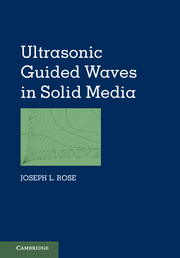Book contents
- Frontmatter
- Contents
- Nomenclature
- Preface
- Acknowledgments
- 1 Introduction
- 2 Dispersion Principles
- 3 Unbounded Isotropic and Anisotropic Media
- 4 Reflection and Refraction
- 5 Oblique Incidence
- 6 Waves in Plates
- 7 Surface and Subsurface Waves
- 8 Finite Element Method for Guided Wave Mechanics
- 9 The Semi-Analytical Finite Element Method
- 10 Guided Waves in Hollow Cylinders
- 11 Circumferential Guided Waves
- 12 Guided Waves in Layered Structures
- 13 Source Influence on Guided Wave Excitation
- 14 Horizontal Shear
- 15 Guided Waves in Anisotropic Media
- 16 Guided Wave Phased Arrays in Piping
- 17 Guided Waves in Viscoelastic Media
- 18 Ultrasonic Vibrations
- 19 Guided Wave Array Transducers
- 20 Introduction to Guided Wave Nonlinear Methods
- 21 Guided Wave Imaging Methods
- Appendix A Ultrasonic Nondestructive Testing Principles, Analysis, and Display Technology
- Appendix B Basic Formulas and Concepts in the Theory of Elasticity
- Appendix C Physically Based Signal Processing Concepts for Guided Waves
- Appendix D Guided Wave Mode and Frequency Selection Tips
- Index
- Plates
- References
11 - Circumferential Guided Waves
Published online by Cambridge University Press: 05 July 2014
- Frontmatter
- Contents
- Nomenclature
- Preface
- Acknowledgments
- 1 Introduction
- 2 Dispersion Principles
- 3 Unbounded Isotropic and Anisotropic Media
- 4 Reflection and Refraction
- 5 Oblique Incidence
- 6 Waves in Plates
- 7 Surface and Subsurface Waves
- 8 Finite Element Method for Guided Wave Mechanics
- 9 The Semi-Analytical Finite Element Method
- 10 Guided Waves in Hollow Cylinders
- 11 Circumferential Guided Waves
- 12 Guided Waves in Layered Structures
- 13 Source Influence on Guided Wave Excitation
- 14 Horizontal Shear
- 15 Guided Waves in Anisotropic Media
- 16 Guided Wave Phased Arrays in Piping
- 17 Guided Waves in Viscoelastic Media
- 18 Ultrasonic Vibrations
- 19 Guided Wave Array Transducers
- 20 Introduction to Guided Wave Nonlinear Methods
- 21 Guided Wave Imaging Methods
- Appendix A Ultrasonic Nondestructive Testing Principles, Analysis, and Display Technology
- Appendix B Basic Formulas and Concepts in the Theory of Elasticity
- Appendix C Physically Based Signal Processing Concepts for Guided Waves
- Appendix D Guided Wave Mode and Frequency Selection Tips
- Index
- Plates
- References
Summary
Introduction
In this chapter the governing equations for circumferential SH waves and circumferential Lamb type waves are developed. For brevity, circumferential SH and Lamb type waves will be abbreviated as CSH-waves and CLT-waves, respectively, from this point onward. Following the development of the single-layer cases, considerations will be made for n-layer annuli. More details on this practical problem can be found in Appendix D, Section 2.11.
Circumferential guided waves are guided waves that propagate in the circumferential direction of a hollow cylinder. They have many practical applications, including the detection of corrosion in piping from in-pipe or in-line inspection (ILI) vehicles. While researchers often use plate-wave solutions to study circumferentially propagating guided waves, this chapter shows that the two cases are quite different, both physically and mathematically, and that significant differences often exist between the plate-wave and circumferential-wave solutions to the governing wave equations. The case in which the two solutions are similar is also discussed in this chapter.
The amount of work published in the area of circumferential guided waves is relatively terse when compared to the body of work relating to wave propagation in the axial direction of hollow cylinders. The treatment of wave propagation in cylindrical layers is first seen in Viktorov (1967). In his text, Viktorov identifies the major physical differences between wave propagation in cylindrical structures and planar structures and specifically addresses the topics of Rayleigh waves on concave and convex surfaces and Lamb type waves in cylindrical layers. He defines the concept of angular wavenumber, which is a physical phenomenon unique to cylindrically curved waveguides. In his treatment of Lamb type waves in a cylindrical layer, Viktorov forms the characteristic equation for an elastic single layer. Because of the limited computational abilities of the time, Viktorov makes several simplifications to arrive at a first approximation.
Information
- Type
- Chapter
- Information
- Ultrasonic Guided Waves in Solid Media , pp. 174 - 208Publisher: Cambridge University PressPrint publication year: 2014
References
Accessibility standard: Unknown
Why this information is here
This section outlines the accessibility features of this content - including support for screen readers, full keyboard navigation and high-contrast display options. This may not be relevant for you.Accessibility Information
- 1
- Cited by
